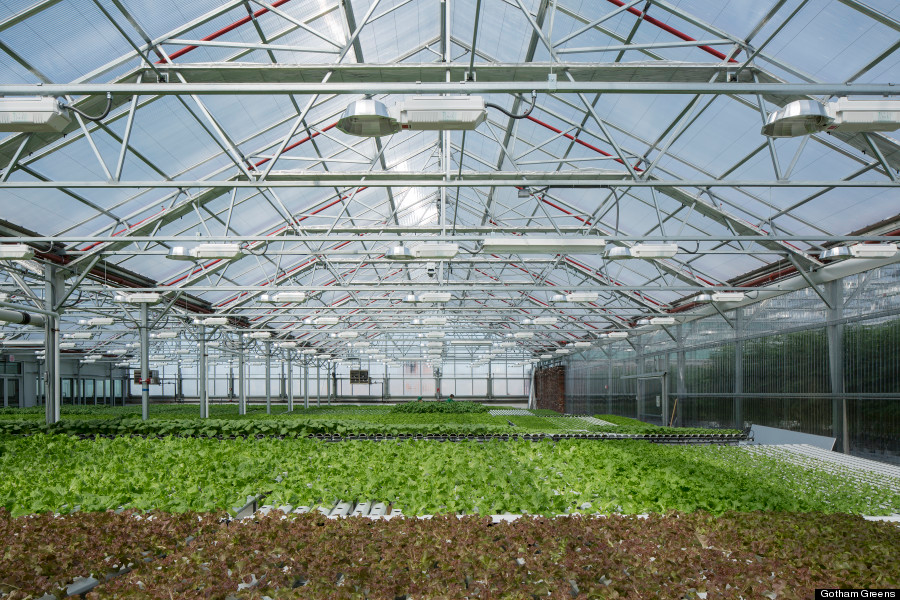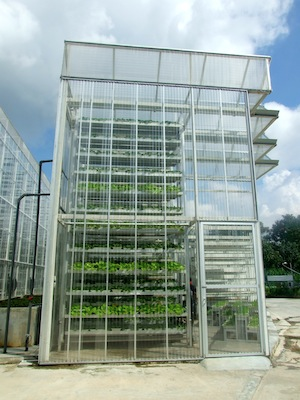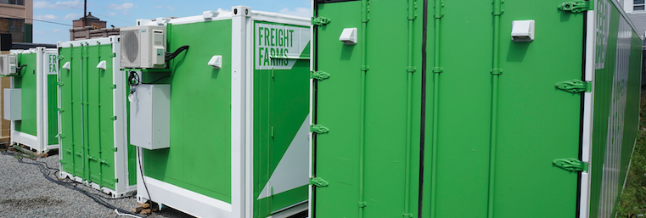Urban Agriculture
By Alex Choi and Sarah Wu
Introduction
It is estimated that by 2050, the global population will reach 9.7 billion.1 People are expected to have higher incomes and more demanding nutrient requirements.2 A significant majority of the growing world population will be concentrated in cities — particularly in resource-strained mega-cities located in the developing countries of Asia, Africa, and Latin America.3 Much of the world’s natural resources, including arable land and freshwater reserves, can barely handle the current food production quotas and are in no state to handle the 70% increase in food production needed to feed the future world population.2 As a result, in order to maintain our current consumption patterns, and in the face of rapidly growing urban poverty and food insecurity, at least 15% of all vegetable production must take place inside cities by 2050.4
The idea of growing and farming plants within cities is captured by the concept of urban agriculture in which food production is integrated and embedded within the urban ecosystem. Crops are grown, picked, sold, and bought all within city borders. As opposed to rural agriculture, urban residents are involved at every step of the food production process, from labor to consumption. Resources come from characteristically urban sources (such as compost for fertilizer and recycled city wastewater for irrigation), and the possibility of spaces being used for farming becomes an additional consideration in urban planning. It isn’t a new idea; an urban farming movement has already proven effective on small scale in many cities around the world.
Urban agriculture provides local residents with more than just food. It provides people with jobs, a better living environment, and improved diets. These benefits tend to most help those in poorer neighbourhoods, areas most affected by poor diet, high crime and high unemployment. Cities as a whole also become less reliant on industrial agriculture, improving food security and making continued urban growth more sustainable. Growing food within cities also reduces the cost of food to the residents by removing the transport fees for moving produce into urban areas. An additional benefit is lowering of atmospheric CO2 levels due to fewer emissions from transportation and more absorption by plants in urban spaces. Finally, urban greenery provides shade, helps counter the heat island effect, and educates residents on where their food comes from.
Urban Agriculture encompasses a broad range of different solutions depending on geography, funding and political climate. Currently implemented and proposed solutions include vertical farms (giant purpose made urban greenhouses), networked, individual urban rooftop farms, mini computer controlled greenhouse boxes, or even integrated urban farming corridors snaking around the city centre. Still, there is a great deal of ongoing research into more productive and efficient strategies, and scientists and urban planners promise many more solutions to the food production crisis to be developed and tested in the near future.
Urban Agriculture Solutions
Rooftop Gardens
A variety of urban agricultural solutions exist to solve the food production problem, of which the most commonly seen is the rooftop garden or greenhouse. These allow crops to be cultivated without taking up extra ground space, in locations that are closely connected and easily accessible by consumers. Such solutions provide aesthetic benefits while also improving stormwater management and rainwater absorption. The greenery also increases urban biodiversity and helps moderate the heat island effect, which occurs when urban infrastructure retains large amounts of heat, causing cities to become significantly warmer than the surrounding natural environment.5 Many follow the green roof concept in which plants are irrigated using recycled water from the buildings below. The buildings can also be insulated, which helps to save energy, reduce energy consumption and reduce costs. Many rooftop gardens also utilize hydroponic cultivation, in which plants are grown in a water-based, no-soil medium that carefully controls pests and rations nutrients.

Figure 1. Gotham Greens rooftop greenhouse in NYC. Source: The Huffington Post
Currently, crops produced from rooftop gardens are more expensive than those from traditional agriculture,6 mainly due to the high initial investment required to construct the greenhouses. These capital costs have hampered greater investment in this technology. Nevertheless, the convenient centralized location attracts more customers, eliminates shipping costs and thus reduces the long-term costs of operation. Rooftop farms also improve the health of the local community and are more environmentally friendly. Implementation challenges include finding suitable locations (building height and space requirements), obtaining permits (depending on city laws), dealing with zoning regulations, and negotiating with city governments. Social hurdles include cultural biases and public resistance against the idea of rooftop farming, which will require education and outreach efforts to address.
Rooftop gardens have very few requirements and resource demands compared to other urban agriculture technologies. They can be constructed anywhere with enough space and sunlight, and resources are relatively easily obtained by virtue of being integrated with the surrounding urban ecosystem. As a result, they are becoming increasingly encouraged by many city governments, small businesses, and nonprofits. An exemplar is New York-based company Gotham Greens,6 which built the first commercial-scale rooftop greenhouse in the US in 2010 (see Figure 1). Covering over 15,000 square feet, this quintessential greenhouse produces over 100,000 pounds of greens annually, uses purely biological pest control, recycles all irrigation water, and is 100% renewable energy powered. While the greenhouses can each require upwards of $10 million to construct, they use “20 times less land and 10 times less water, and eliminate the need for pesticide use and fertilizer runoff,” according to the website, which will undoubtedly pay back costs in the long run. Gotham Greens has since multiplied its square footage many times and begun to spread across the US, most notably into Chicago, demonstrating that its solution is applicable to a variety of different cities.
Vertical Farming5
Vertical farming is another means of implementing urban agriculture. Vertical farms are housed in large buildings with the single purpose of growing urban produce and can range in scale from large domestic greenhouses to skyscrapers. Their main advantage over other solutions is high theoretical food production efficiency. The environment in a vertical farm can be carefully controlled and monitored for optimal food production efficiency, from the nutrients being fed to the plants through the hydroponic growth medium, to the light and temperature of building. By producing food so efficiently and with little to no transport fees, vertical farms are predicted to be able to outcompete current rural agriculture. For instance, a 30-story vertical farm occupying as much ground space as a square city block could yield the same volume of food as 2,400 acres of standard fields.6
Currently, a commercial vertical farm in Singapore,7 operated by the company Sky Greens, is producing over half a ton of greens every day. The farm consists of a thousand vertical A-frame conveyor towers, each with the footprint of 60 square feet.8 Vertical farming is especially viable in Singapore because of its unique geographical situation, tropical climate, dense population, and high reliance on imported food from abroad. To maximize efficiency, Sky Greens houses its farms in indoor greenhouses and uses a technology called an A-frame conveyor (see Figure 2). Named “A Go-Grow,” these water-powered, rotating frame structures specially ensure that plants grown in troughs receive adequate lighting, since they are normally overshadowed by plants higher up. Water used to mechanically turn the towers is then recycled to water the vegetables themselves, resulting in each tower consuming as little energy as a 60-Watt light bulb per day.1 The year-round sunlight and high average temperatures in Singapore means very little heating is required for each tower, so pricing is kept competitive. For instance, even though a 200g packet of bok choy from Sky Greens costs $1.25 compared to the normal $0.80, locals say they are willing to pay the difference because of the freshness of the produce.7 Although vertically farmed produce is currently more expensive than regular produce, the aim is to create a cheaper food source once the project expands and people are more willing to see vertical farming as a solid financial investment. With the improved food production brought about by vertical farming, Singapore managed to produce 12% of its current leafy greens consumption.7

Figure 2. A Go-Grow tower in Singapore. Source: United Nations University
Vertical farming is becoming a reality in cities away from the equator, too. Swedish company Plantagon is currently constructing the World Food Building (International Centre of Excellence for Urban Agriculture) in Linköping, Sweden — a sixteen story mixed use skyscraper (see Figure 3). The idea is to integrate offices, hotel rooms, and other traditional urban facilities around a giant multilayer greenhouse core so that the different spaces mutually enhance each other. For instance, the greenhouses can offer shading, thermal insulation, and clean air for the offices. Other design considerations include a solar shell, light-diffusing sandwich panels, and an efficient helical tower structure to house the crops themselves.9 Plantagon COO Owe Pettersson hopes that, once built, “the Plantagon Greenhouse will be a model for the whole world to demonstrate that you can actually grow food efficiently and safely in a large city.”10

Figure 3. World Food Building in Linköping, Sweden. Source: Mynewsdesk.
Emerging Solutions
As urban agriculture is still in its infancy, a number of smaller solutions still in development are attracting attention. Boston-based startup Freight Farms is building insulated, hydroponic greenhouses inside old shipping containers (see Figure 4). They’re called Leafy Green Machines (LGMs) and consist of dense stacks of mini-vertical farm towers. Compact and easily transportable, LGMs are equipped with advanced sensors and controllers to produce high volumes of food year-round. Unfortunately, costs are still very high – $85,000 upfront and $13,000 for annual operations – but new improvements are hoping to lower the financial barrier to entry. In addition, the high yield is much more sustainable and cost-effective in the long run. For instance, mini-lettuce heads only have a four week growing cycle inside LGMs. This means that buyers can achieve 12 full farm harvests per year, producing more than twice as many mini-lettuce heads in their shipping container as traditional farmers do on an entire acre of land. LGMs can be placed almost anywhere due to their completely closed growing environment and Freight Farms is currently working on expanding internationally.

Figure 4. Leafy Green Machines by Freight Farms. Source: Freight Farms (LinkedIn).
Urban agriculture is now attracting an even wider research base. New technologies such as Open Ag, currently under development at MIT, promise to usher in a new era of urban agriculturally inspired food solutions. Open Ag is a miniaturized greenhouse in which all the preconditions for growing the plants within are determined by the user and executed by what the developers call a “food computer.” The strength of Open Ag lies in its software; users join an open source agricultural networking site where fellow growers can share data about the preconditions they set, how their plants are growing, and the nutritional data of the plants after harvest. The goal is not only to make fresh tasty organic greens become a staple of every home, school and office, but also to make this food tailored to the nutritional requirements of each individual.
Although food computers could help improve the food supplies of cities, they cannot produce enough to satisfy the food requirements of an entire population. Instead, food computers would be the data producers and the educators. With so many food experiments going on around the world producing large volumes of growing data, optimised growing conditions for certain nutritional requirements could be found very quickly and implemented into larger commercial farms. Food computers would also help expose and educate people to the idea of urban agriculture. Food computers are designed to be convenient; they require minimal actual growing know – how since working preconditions are already uploaded. People who wouldn’t otherwise want to grow crops could do so very easily, even with no prior knowledge. Perhaps those who bought their first food computer would eventually start growing food in their balconies, backyards or rooftops. Children at school could also get first hand experience growing food as well as eating their own healthy greens.
Conclusion
The increase in urbanisation and the rise of megacities, especially in developing countries, coupled with global climate change, has made finding a viable food solution for sustainable growth incredibly important. The current food production system is barely able to cope with our food needs and another solution is needed. In the last fifteen years, urban agriculture has gained significance as a social, economic, and environmental movement. Within city departments around the world, from towns to metropolises, food systems are gradually being recognized as essential to city planning, as fundamental as systems for energy, water, transport and construction.
Urban agriculture encompasses a huge variety of solutions, each specific solution filling a geopolitical and economic niche. Vertical farming, for example, would be a very viable solution in tropical climates with high population density and large financial capital. Many East Asian cities like Tokyo, Hong Kong, or Shanghai could be viable candidates, following the footsteps of successful vertical farming projects in Singapore. Rooftop farms could be a wider ranging solution particularly suitable for cities in the global north and the West. The lower urban population density and lower social stigma associated with growing food at home means a more decentralised but socially networked solution would work better. Freight farms and food computers are higher end urban agriculture based products that would have a much broader set of viable environments, especially in more developed economies, if they prove to be commercial successes.
Urban agriculture helps take the issues surrounding megacities – huge population, high rise buildings, high unemployment, poor diet, lack of green space – and turn them on their head. High rises become vast vertical jungles filled with balcony and rooftop produce; homes, classrooms, and offices become food data production facilities; and even whole buildings are constructed with the sole purpose of creating food. Many planners realize that urban agriculture is becoming a necessity for any city of the future. Although many of these technologies are still in their infancy, there is real economic momentum behind these projects. A sustainable model city for 2050 is no longer a pie in the sky, but fast becoming a reality.
